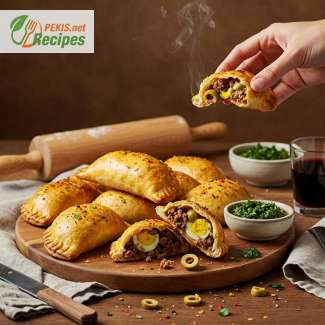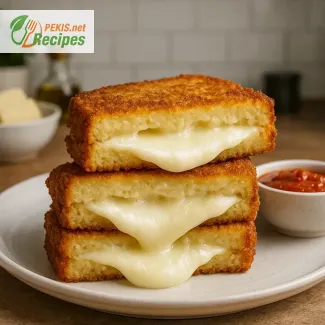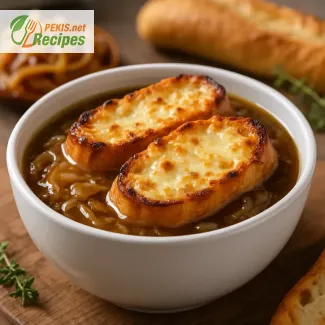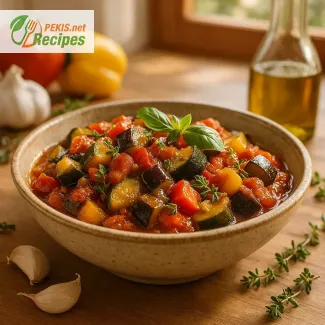
Discover the Rich Tradition Behind the Perfect Beef Empanada
The History and Cultural Significance of Empanadas
Empanadas are more than just a dish; they are a culinary treasure deeply rooted in tradition. Originating from Spain and spreading across Latin America, these deliciously crispy and savory pastries have become a staple in countless kitchens. Each country has its own interpretation, with Argentina, Colombia, Mexico, and the Philippines adding their unique twists to the recipe.
The name "empanada" comes from the Spanish word empanar, meaning "to coat in bread." This refers to the process of wrapping a flavorful filling in a thin dough before baking or frying it to golden perfection. Though fillings can vary from chicken to seafood or vegetables, beef empanadas remain the most beloved variation, thanks to their rich, spiced filling and satisfying texture.
What Makes Beef Empanadas Irresistible?
Empanadas are the ultimate comfort food, combining a crispy, flaky crust with a juicy and well-seasoned filling. The magic of a perfect empanada lies in the balance of textures and flavors. The dough, whether baked for a delicate crunch or fried for extra crispiness, encases a savory filling that bursts with succulent, spiced beef, onions, garlic, and a medley of traditional spices.
The addition of paprika, cumin, and oregano enhances the depth of flavor, while olives and hard-boiled eggs—common in Argentinian empanadas—add a layer of richness and complexity. The result is a handheld delight that can be enjoyed as a snack, appetizer, or full meal, making it perfect for any occasion.
The Secret to the Perfect Empanada Dough
One of the defining aspects of a great empanada is its dough. A well-made dough should be buttery yet sturdy enough to hold the filling without breaking apart. Many traditional recipes use all-purpose flour, butter, and a touch of salt, while some variations incorporate lard for a more authentic flavor.
The key to achieving the perfect texture is letting the dough rest before rolling it out. This step ensures that the gluten relaxes, resulting in a tender, flaky crust that crisps up beautifully when baked or fried.
The Best Filling for a Classic Beef Empanada
While there are countless variations of empanada fillings, a well-seasoned beef mixture remains the gold standard. The best beef empanadas feature juicy, tender ground beef, sautéed with onions, garlic, and aromatic spices to create a bold and savory filling. The secret to locking in moisture and enhancing the flavor is slow cooking the beef with a splash of broth or tomato sauce, allowing the ingredients to meld together perfectly.
Some regional variations include:
- Argentinian empanadas – Often include green olives, boiled eggs, and even raisins for a sweet-savory contrast.
- Colombian and Venezuelan empanadas – Typically use cornmeal dough for a slightly different texture.
- Spanish empanadas – Feature a flaky puff pastry-style crust and may include ingredients like tuna or chorizo.
Why Beef Empanadas Are a Perfect Dish for Any Occasion
Whether you’re hosting a party, preparing a family dinner, or looking for a delicious on-the-go meal, beef empanadas are a crowd-pleaser. Their versatility and convenience make them ideal for any occasion.
- Great for meal prep – Empanadas can be made in advance and frozen, allowing for a quick and easy meal when needed.
- Perfect for gatherings – Their handheld size makes them an excellent finger food for parties, picnics, and special events.
- Customizable – You can easily adjust the spice level, fillings, and dough texture to suit your taste preferences.
Serving and Enjoying Your Beef Empanadas
While empanadas are delicious on their own, they become even more irresistible when paired with the right dipping sauce. Some popular options include:
- Chimichurri – A tangy, herb-based Argentine sauce that adds freshness.
- Salsa criolla – A South American onion and tomato relish that enhances the empanada’s richness.
- Spicy ají sauce – A fiery yet flavorful dip for those who love an extra kick.
For a truly authentic experience, serve warm empanadas alongside a glass of Malbec wine or a refreshing homemade lemonade, balancing the rich flavors with the perfect beverage.
A Taste of Tradition in Every Bite
Making homemade beef empanadas is a rewarding experience that allows you to connect with a centuries-old culinary tradition. Whether you prefer them baked or fried, stuffed with classic fillings or innovative twists, these golden, crispy delights are guaranteed to satisfy.
Ready to master the art of making authentic beef empanadas? Follow our step-by-step recipe and enjoy the magic of this beloved dish in your own kitchen!
- Prepare the dough: In a large bowl, combine flour and salt. Add chilled butter and mix with your fingertips until the mixture resembles coarse crumbs. Add egg yolk and cold water, mixing until the dough comes together. Knead briefly, wrap in plastic, and refrigerate for at least 30 minutes.
- Prepare the filling: Heat olive oil in a pan over medium heat. Add onions and sauté until translucent. Add garlic and ground beef, cooking until browned. Stir in cumin, paprika, oregano, salt, and pepper. Pour in beef broth and cook for 5 more minutes, allowing flavors to meld. Remove from heat and let cool. Mix in chopped hard-boiled egg and olives.
- Assemble the empanadas: Roll out the dough on a floured surface to a thickness of about 3 mm (⅛ inch). Cut out 12 cm (5-inch) circles. Place 1-2 tablespoons of filling in the center of each circle, fold the dough over to form a half-moon shape, and press the edges with a fork to seal.
- Bake the empanadas: Preheat the oven to 200°C (400°F). Place empanadas on a parchment-lined baking sheet. Brush with beaten egg and bake for 18-20 minutes, or until golden brown. Let cool slightly before serving.
Enhancing the Classic Beef Empanada Recipe
Elevating Flavor with Ingredient Adjustments
A well-made beef empanada should have a rich, well-balanced flavor that combines savory, slightly smoky, and mildly spiced elements. Adjusting ingredients can make a significant difference in taste and texture.
Using Higher Quality Beef
The quality of ground beef directly impacts the flavor and juiciness of the empanada filling. Opting for 80/20 ground beef (80% lean, 20% fat) ensures a juicier texture. Using a leaner cut may result in a dry filling, so balancing it with olive oil or broth is recommended. For an even deeper flavor, hand-chopping beef sirloin instead of using ground meat enhances the texture and gives a more authentic Argentine-style empanada.
Adding More Depth with Seasonings
Traditional seasonings such as paprika, cumin, and oregano are essential, but adding smoked paprika instead of regular paprika enhances the earthy, slightly smoky flavor. A small amount of cinnamon (just a pinch) can subtly enhance warmth and complexity, especially when paired with raisins, as found in certain Latin American variations.
Enhancing Texture with Additional Ingredients
Some regions incorporate green olives, raisins, or even diced potatoes into the filling, creating a contrast between sweet, salty, and umami flavors. If adding raisins, soak them in warm water or a splash of rum before mixing them into the filling to bring out their natural sweetness.
Improving the Dough for a Better Crust
A perfect empanada crust should be flaky, yet strong enough to hold the filling without breaking. Here are some ways to enhance the dough:
Using Butter Instead of Lard
Traditional empanada dough is often made with lard, which adds richness. However, using butter instead of lard creates a flakier texture and adds a slightly more refined taste. If aiming for a crispier crust, replacing part of the butter with a small amount of vegetable shortening works well.
Adding Vinegar for Tenderness
A small amount of vinegar (about 1 teaspoon per 300 grams of flour) helps to tenderize the dough by inhibiting gluten development. This results in a less chewy, more delicate crust that is easier to work with and bakes beautifully.
Resting the Dough Properly
One of the most common mistakes when making empanada dough is not allowing it to rest long enough. After kneading, the dough should rest for at least 30 minutes in the refrigerator. This prevents it from becoming too elastic, making it easier to roll out and less likely to shrink during baking.
Why Homemade Empanadas Are Superior
While store-bought empanadas may offer convenience, homemade empanadas have a richer taste and better texture. The primary advantages of making them from scratch include:
- Control over ingredients – You can choose higher quality meat, fresh vegetables, and healthier oils.
- Customization – Homemade empanadas allow you to adjust seasonings, fillings, and dough thickness to your liking.
- No preservatives – Many frozen or pre-packaged empanadas contain preservatives and artificial flavor enhancers, which can affect taste and nutritional value.
Common Mistakes to Avoid
Even experienced cooks can make critical errors when preparing empanadas. Here are some pitfalls to watch out for:
Overfilling the Empanadas
A common mistake is adding too much filling, which can cause the empanadas to burst open while baking or frying. A proper ratio is about one to two tablespoons of filling per empanada.
Not Sealing the Edges Properly
A weak seal can lead to leakage of juices, making the empanadas dry. Always use a fork or hand-crimping method to seal the edges securely. For an even tighter seal, brushing a small amount of water or egg wash around the edges before folding helps them stay closed.
Cooking at the Wrong Temperature
If the oven is too cold, the dough won’t crisp up properly. If it’s too hot, the empanadas may burn before the filling is fully cooked. The ideal baking temperature is 200°C (400°F). For fried empanadas, the oil should be at 175°C (350°F) to achieve a golden-brown crust without absorbing too much oil.
Healthier Alternatives Without Compromising Flavor
For those looking to make a healthier version of traditional empanadas, several modifications can be made without sacrificing flavor or texture.
Using Whole Wheat Flour
Replacing half of the all-purpose flour with whole wheat flour increases fiber content, adding a nutty depth to the dough.
Opting for Leaner Protein Options
Instead of ground beef, try using:
- Ground turkey or chicken – These options have less saturated fat while maintaining a rich taste when seasoned properly.
- Lentils or mushrooms – For a vegetarian alternative, using finely chopped portobello mushrooms or lentils provides a hearty, umami-packed filling.
Baking Instead of Frying
Although fried empanadas are undeniably delicious, baking them is a healthier alternative that still results in a crisp, golden crust. To mimic the flaky texture of fried empanadas, brushing the tops with a mixture of egg wash and a small amount of olive oil before baking enhances their color and crunch.
Experimenting with Regional Variations
One of the best ways to elevate the traditional recipe is by exploring regional variations. Some exciting twists include:
- Spicy Mexican Empanadas – Adding chipotle peppers or chili powder for a smoky, spicy kick.
- Cheese-Filled Argentinian Empanadas – Incorporating melted provolone or mozzarella for a gooey, rich filling.
- Caribbean-Style Empanadas – Infusing the beef with coconut milk and curry powder for an exotic twist.
Perfecting the Art of the Empanada
Mastering the authentic beef empanada requires attention to detail, quality ingredients, and a willingness to experiment. Whether enhancing the dough, adjusting the filling, or trying new cooking methods, every small change contributes to a more flavorful and enjoyable experience.
With these techniques, anyone can transform a traditional empanada into an unforgettable dish, perfect for any gathering, celebration, or simple homemade meal.
Contains gluten (flour), eggs, and possible traces of dairy (butter).
Ingredient Substitutions for Allergies & Gluten-Free Variations:
- Gluten-free dough: Replace all-purpose flour with a gluten-free flour blend.
- Dairy-free: Use margarine or coconut oil instead of butter.
- Egg-free: Substitute the egg yolk in the dough with 30 ml (2 tbsp) of water or dairy-free milk.
- Iron (2 mg per serving): Essential for red blood cell production.
- Vitamin B12 (1.1 µg per serving): Supports nerve function and DNA synthesis.
- Zinc (1.5 mg per serving): Strengthens the immune system.
- Paprika: Contains capsaicin, which has anti-inflammatory properties.
- Oregano: Rich in flavonoids, supporting immune health.
- Olive oil: Provides polyphenols that protect cells from oxidative damage.





